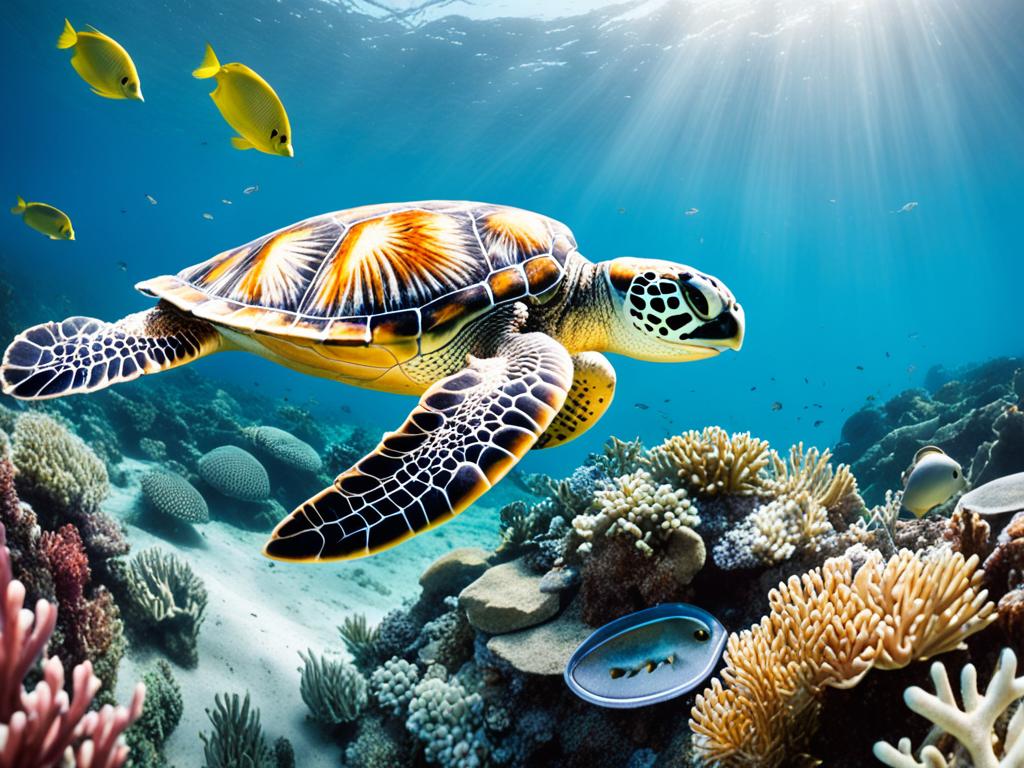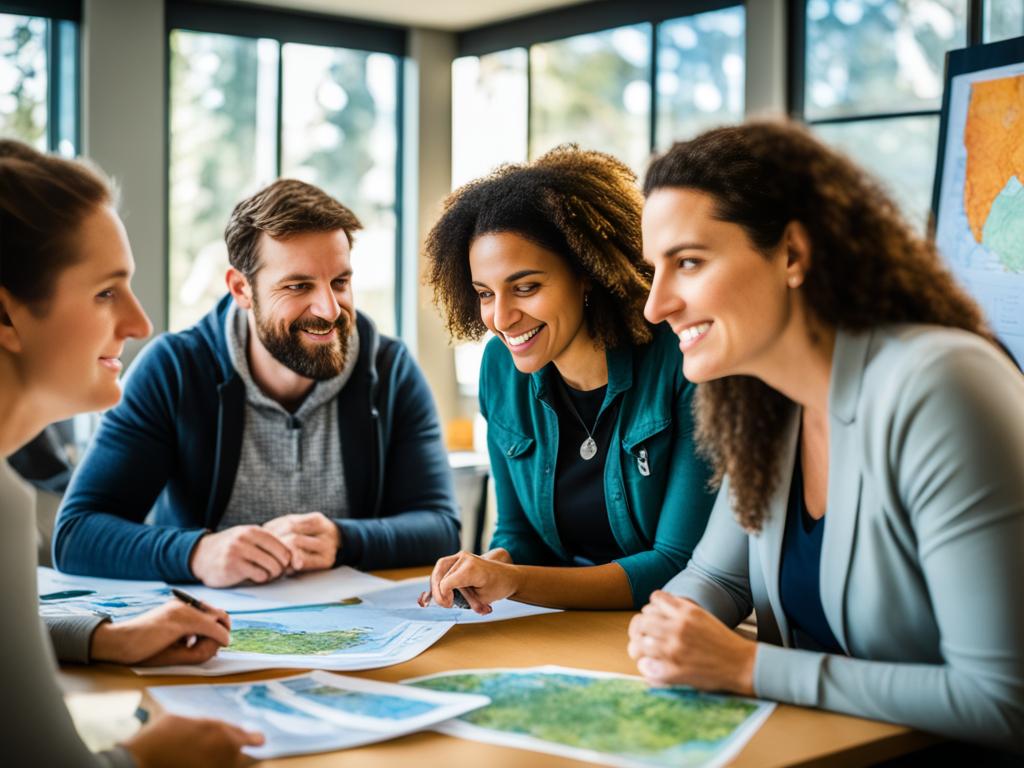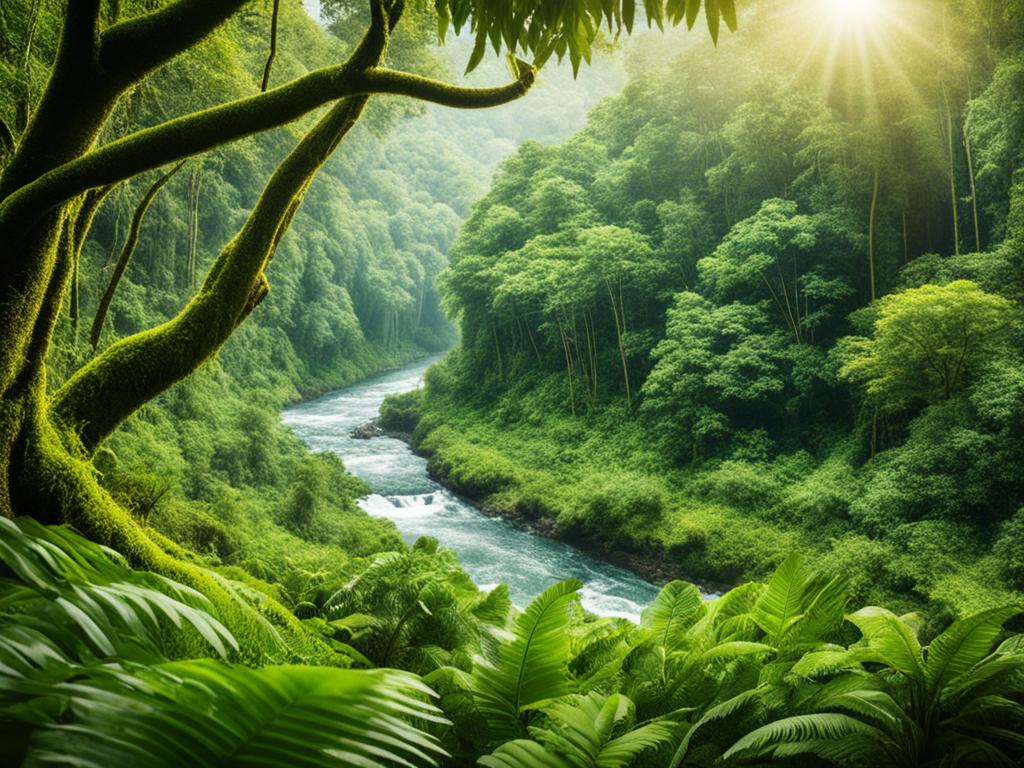The world is seeing a big problem with many plants and animals becoming endangered. This makes it very important to save them. The Alaska Fisheries Science Center learns a lot about sea animals in Alaska. They also teach people about fish, killer whales, and make art about fish in Spanish for the West Coast region. At the same time, Jane Goodall’s “Jane’s Endangered Animal Guide” is a fun book. It shows young people 10 animals that are in danger. It talks about their problems and how people are trying to help. It makes young people want to take care of the Earth.
This guide is here to talk more about animals and plants that are in danger. It looks at why they are in trouble and why we need them. It also shows what we can do to help. When we know these things, we can help more. This way, we make our Earth a better place for all living things.
Key Takeaways
- The Endangered Species Act (ESA) has successfully prevented the extinction of many species and conserved their habitats.
- Federal agencies, tribes, and private/nonprofit organizations actively contribute to species recovery efforts.
- Innovative strategies, such as captive breeding programs and habitat restoration, are crucial for species reintroduction and recovery.
- Sustainable practices, including eco-tourism and renewable energy, can play a significant role in protecting endangered species and their ecosystems.
- Technological advancements and research are vital in monitoring, understanding, and conserving endangered species and their habitats.
Understanding Endangered Species
Endangered species are plants and animals at high risk of disappearing. This can happen soon or over time. They face threats like losing their homes, being overhunted, battling new invasive species, dealing with pollution, and handling climate changes. It’s vital to know these causes to save them and the places they live.
Defining Endangered Species
The IUCN considers a species endangered if its numbers are dwindling fast and its area of life is shrinking. This label helps us rate how close a species is to dying out. It guides efforts to help those at highest risk, like the critically endangered, endangered, and vulnerable species.
Causes of Species Endangerment
Big reasons for species facing danger are losing their homes and being overused. Poaching and too much harvesting hurt them. So do new species moving in and making life hard, pollution, and changing climates. These upsets threaten the balance of nature, affecting the survival of many.
Impact on Ecosystems
When species vanish, it harms the whole ecosystem. It messes up the natural order of life, impacting everything else. Losing key species is especially bad. They are essential for keeping nature’s balance and functions just right.
Biodiversity and Its Significance
The idea of biodiversity means the incredible number of living things on Earth. This includes all kinds of plants, animals, and other life forms. Even tiny organisms like bacteria and fungi are part of it. They all work together to keep the Earth’s systems balanced, creating a safe space for life to flourish.
Central to this is genetic diversity. It’s the variety found within each species. This type of diversity helps living beings adapt to changes and survive different challenges. The many species and habitats also keep the Earth’s climate and water cycles in check. This makes sure life on our planet can go on for a long time.
But there’s an issue. Human actions are causing a huge loss in biodiversity. Activities such as destroying habitats and using up resources too quickly are big problems. They’re making unique plants and animals disappear much faster than normal. This speed of loss is a serious threat to Earth’s natural balance.
This loss is happening so fast, it’s not natural. It’s putting many species at risk of vanishing forever. Such a change would have a big impact. The loss of one species can upset a whole ecosystem. This could harm the health and strength of the Earth’s natural systems.
Thankfully, people and groups are working to protect biodiversity. They are doing things like creating safe zones for plants and animals. They’re also working to bring back species close to disappearing. These efforts are key to saving life on Earth as we know it.
Threatened Ecosystems and Habitats
The efforts to protect wildlife and ecosystems are very crucial. Many areas, like forests and coral reefs, face big risks. These places are homes to many endangered species. Saving them helps keep our world in balance.
Rainforests
Rainforests have so many types of plants, animals, and insects. But, they are in danger from logging, agriculture, and mining. Protecting them is critical. It helps keep the mix of life on Earth healthy.
Coral Reefs
Coral reefs are key for many sea creatures. But, dangers like ocean acidification and warming waters harm them. Saving these reefs is top priority. It protects the oceans’ ecosystems.
Arctic Regions
The Arctic, home to the polar bear, is warming fast. This change hurts life in the cold. We must act to lessen this harm. It’s important for these wildlife areas.
Comprehensive Guide to Endangered Species and Conservation Efforts
Identifying Endangered Species
The first big step to help endangered species is to know them really well. The IUCN Red List is a key tool. It checks the world’s plant and animal species to see which are most at risk. This helps governments, scientists, and groups aim their help where it’s needed most.
Conservation Strategies
A lot of work goes into saving species in danger. Protecting where they live is vital. This happens by making safe zones and fixing places that were ruined. Species are sometimes helped by being bred or released back into the wild.
Other good methods include eco-friendly tourism and farming, plus using more clean energy. These ways of living could stop much of the harm we cause. This means people and companies can help save nature and keep our planet healthy for everyone.
Success Stories
There are many tales of survival against the odds. The bald eagle in the U.S. is a great example. Thanks to strong laws and safe areas, it came back from near extinction. Now, it flies free as a symbol of our fight to protect nature.
The Arabian oryx, the black-footed ferret, and the California condor also show what we can do together. Governments, groups, and locals joined forces to save these animals. Their victories shine as examples of what is possible when we work as one for nature.

Wildlife Protection Laws and Policies
Around the world, governments and groups work together to make laws and policies that keep endangered species safe. In the U.S., the Endangered Species Act is a key part of this effort. It controls how vulnerable animals and plants are used and cares about endangered ecosystems.
On a bigger scale, the Convention on International Trade in Endangered Species of Wild Fauna and Flora (CITES) and the Ramsar Convention on Wetlands are big players. They help the world manage the trade of endangered species. They also work to make safe places where wildlife and their homes can heal and grow strong.
The U.S. Fish & Wildlife Service uses many laws, treaties, and regulations to protect animals at home and abroad. Even Congress has made extra rules and details to make things clear for everyone. These rules are checked by the public and then written down for everyone to follow every year.
The U.S. Fish and Wildlife Service also talks to Congress about making better laws to protect our wildlife. This team effort makes sure that the laws stay up-to-date and work well to save endangered animals and their homes.
Environmental Advocacy and Awareness
Stakeholders like NGOs and local communities are crucial in saving endangered species and threatened lands. They raise awareness, push for better policies, and help with direct conservation work.
Non-Governmental Organizations
Groups like the World Wildlife Fund and Conservation International lead the fight to save plants and animals. These NGOs use their skills and worldwide connections to do research and talk to decision-makers. They also help put real protection plans in place.
Community Engagement
Local people are important, too. They help a lot by using sustainable ways, getting involved in science projects, and speaking up for nature. This sort of action saves landscapes and helps animals bounce back, while also teaching about caring for the Earth.

Working together, NGOs and local efforts, a Comprehensive Guide to Endangered Species and Conservation Efforts can start big changes. These are needed to fight extinction and keep nature in balance all over the planet.
Sustainable Practices
Sustainable practices are key in protecting species in danger. They include things like eco-tourism, sustainable farming, and using clean energy. These methods help meet wildlife and human needs, ensuring both can thrive long-term.
Eco-tourism
Eco-tourism is all about going to natural spots in a mindful way. It brings money to help save wildlife while educating visitors. By choosing eco-friendly trips, people aid in saving endangered animals and their homes. This builds a love for nature.
Sustainable Agriculture
Engaging in sustainable farming and growing food without harming the land can save habitats. It protects diverse plant and animal life. By farming in a way that supports nature, we keep endangered places alive.
Renewable Energy
Turning to sources like sun and wind for energy helps save at-risk animals. It cuts down on things like air pollution and destruction of wild homes. These clean power sources help keep special places safe for wildlife to live and grow.
Species Recovery and Reintroduction
Conservation groups are working to protect rare animals and bring back nature’s variety. They use special methods like helping animals breed in safe places and fixing up their homes. These efforts are key in saving animals on the brink and putting them back in the wild where they belong.
Captive Breeding Programs
Captive breeding is a critical part of saving animals from going extinct. By keeping a careful watch and helping certain species have babies, we can grow their numbers. Then, they get a chance to go back home. A great example is the work done with Tasmanian devils. Since 2006, a special group of devils has been kept safe for the future, mixed with others for breeding. This ensures they have a good, strong future ahead, with a variety of genetic types for breeding.
Habitat Restoration
Fixing natural homes is also key beside breeding programs. By fixing up or saving lands that were hurt, we make it possible for animals to have a place to live. A really cool project was bringing back the European Bison to the British Isles in 2022. These animals hadn’t lived there for a very long time. It shows how important saving homes is and that animals can bounce back when we give them a chance.
But, helping animals come back is not always easy or quick. It takes a lot of checking and teamwork to see if we are succeeding. People from different fields like science and conservation work together to make sure our plans are working well. This helps us know if we are doing a good job in saving nature and the animals that call it home.

Extinction Risk and Consequences
The loss of endangered species can cause big problems for the ecosystems we depend on. When a species goes extinct, it messes up the ecosystem’s balance. This affects other creatures and how well the system works.
For example, if a keystone species disappears, everything might fall apart. These species are like the glue that keeps things together.
If we lose biodiversity, there’s less variety in nature. This reduces the ability of living things to handle changes and problems. A study in 2005 by Wilcove and Master showed how serious the situation is in the United States.
The U.S. has the Endangered Species Act (ESA) from 1973 to help. But, some researchers like Gibbs, Currie, Suckling, Slack, and Nowicki don’t think it’s always effective. As the worldwide issue of biodiversity loss gets worse, it’s key to act fast. We need to protect our planet’s ecological balance with smart and caring practices.
The Role of Technology and Research
Technology and research are key in saving endangered animals and their homes. Now, scientists can watch over rare animals better, thanks to things like remote sensing and DNA studies. These tools help experts see where animals live, how they’re doing, and what dangers they face.
DIY maker groups and better manufacturing from the Fourth Industrial Revolution are also joining in. The conservation world is starting to shine with new ideas. They are making their own tech for specific needs, not just using what’s already out there.
They use tools like sensor networks and special gadgets to watch animals. Also, new tech such as drones with smart cameras are changing how we keep track of wildlife. By looking at past info, machines can even guess what problems might come in the future. Basically, AI and data help us protect animals better against climate and other changes.
Source Links
- https://www.fisheries.noaa.gov/insight/recovery-endangered-and-threatened-species
- https://www.fws.gov/program/endangered-species
- https://www.endangered.org/importance-of-the-endangered-species-act/
- https://www.ifaw.org/journal/endangered-species-terms-definitions
- https://www.amnh.org/research/center-for-biodiversity-conservation/what-is-biodiversity
- https://lawshelf.com/shortvideoscontentview/federal-efforts-to-ensure-biodiversity-the-endangered-species-act/
- https://www.nrdc.org/stories/biodiversity-101
- https://www.fema.gov/floodplain-management/wildlife-conservation/benefits-conserving-endangered-species
- https://www.fws.gov/service/esa-section-7-consultation
- https://www.iucnredlist.org/about
- https://www.hcn.org/articles/endangered-species-a-westerners-guide-to-the-endangered-species-act/
- https://www.fws.gov/laws
- https://www.fisheries.noaa.gov/national/endangered-species-conservation/endangered-species-act-guidance-policies-and-regulations
- https://www.endangered.org/10-easy-things-you-can-do-to-save-endangered-species/
- https://library.fiveable.me/ap-enviro/unit-9/endangered-species/study-guide/nPHB7UlREP5mNGlxRUfD
- https://www.endangered.org/15-ways-to-help-protect-endangered-species/
- https://www.iisd.org/articles/deep-dive/protecting-endangered-species
- https://ecologyforthemasses.com/2020/11/10/a-beginners-guide-to-endangered-species-reintroduction/
- https://www.perc.org/2023/09/20/a-field-guide-for-wildlife-recovery/
- https://www.ncbi.nlm.nih.gov/pmc/articles/PMC6482936/
- https://www.ncbi.nlm.nih.gov/pmc/articles/PMC8490933/
- https://medium.com/@jrparker07/ai-in-wildlife-conservation-protecting-endangered-species-with-technology-8655faff3546


